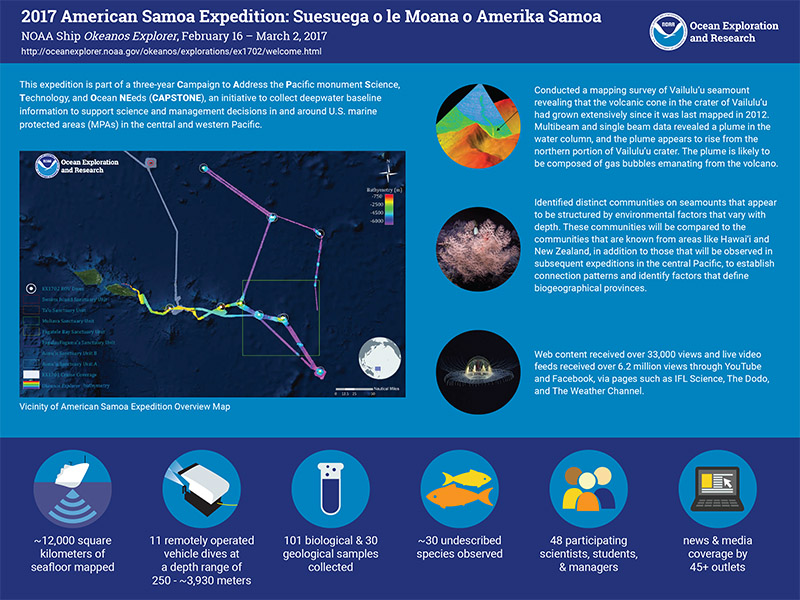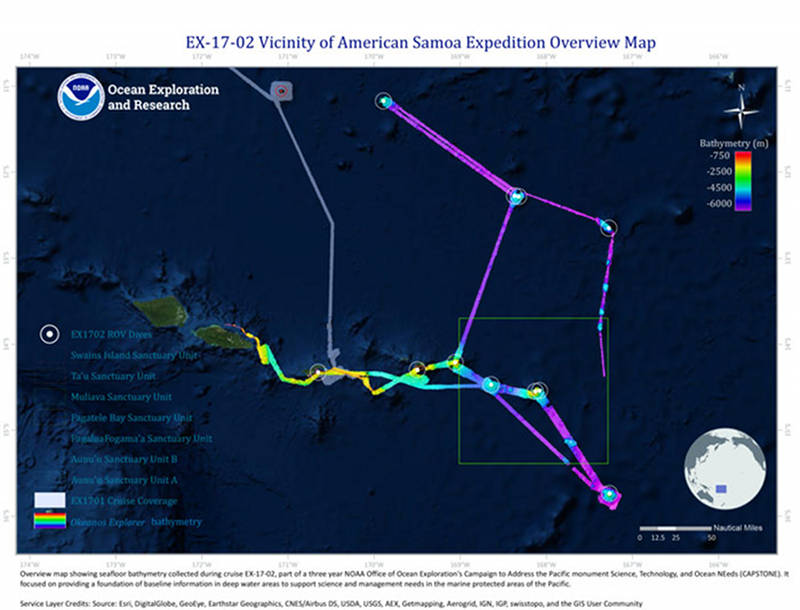
February 16 – March 2, 2017

Infographic summarizing accomplishments from part one of the 2017 American Samoa expedition. Image courtesy of the NOAA Office of Ocean Exploration and Research, 2017 American Samoa. Download (pdf, 953 KB).
This expedition is part of the three-year Campaign to Address the Pacific monument Science, Technology, and Ocean NEeds (CAPSTONE), a foundational science initiative to support science and management decisions within and around U.S. marine protected areas in the central and western Pacific. In addition to collecting valuable data on the biology and geology of the region, throughout the expedition, scientists encountered a range of beautiful and unusual life, highlighting the uniqueness and importance of these national symbols of ocean conservation. Video courtesy of the NOAA Office of Ocean Exploration and Research, 2017 American Samoa. Download (mp4, 99.4 MB).

Overview map showing seafloor bathymetry collected and ROV dives conducted during part one of the 2017 American Samoa expedition. Image courtesy of the NOAA Office of Ocean Exploration and Research, 2017 American Samoa. Download image (jpg, 65 KB).
The 2017 American Samoa Expedition Part 1: Suesuega o le Moana o Amerika Samoa, was a 14-day telepresence-enabled expedition to explore unknown and poorly understood areas in American Samoa and Samoa with a focus on Rose Atoll Marine National Monument and National Marine Sanctuary of American Samoa. Throughout the expedition, the team conducted daytime remotely operated vehicle (ROV) dives; overnight mapping operations; and conductivity, temperature, and depth (CTD) rosette operations. Expedition priorities included a combination of science, education, outreach, and open data objectives that will support management decisions at multiple levels. Major accomplishments from the expedition are summarized below. Download a PDF version of this summary. (3.8 MB).
Ever wonder why so many of our dives take place on seamounts? Here’s a good explanation from Dr. Santiago Herrera, biology lead for the expedition, on how seamounts become oases of life within an otherwise flat abyssal plain. Video courtesy of the NOAA Office of Ocean Exploration and Research, 2017 American Samoa. Download (mp4, 90.2 MB).
Conducted 11 ROV dives from 250 to 4,000 meters depth to survey for a diversity of benthic habitats and features, including high-density deep-sea coral and sponge communities, hydrothermal vents, bottomfish habitats, seamounts, and the water column.
Mapped more than 12,000 square kilometers of seafloor—an area 60 times the land area of American Samoa!
On February 24, 2017, the ninth dive of the expedition, we explored Vailul‘u seamount, an active volcano lying in the eastern region of the Samoan hotspot. Video courtesy of the NOAA Office of Ocean Exploration and Research, 2017 American Samoa. Download (mp4, 123.1 MB).
Investigated a variety of geological features, including seamounts, volcanoes, manganese- encrusted seafloor, and an active hydrothermal vent site.
Analysis of samples collected during dives can help to give us a much better perspective on the evolution of life in the ocean. Video courtesy of the NOAA Office of Ocean Exploration and Research, 2017 American Samoa. Download (mp4, 23.2 MB).
Collected 9.5 TB of data, including multibeam sonar, single beam echo sounder, subbottom profiler, Acoustic Doppler Current Profiler (ADCP), eXpendable Bathy Thermograph (XBT), CTD, surface oceanographic and meteorological sensors, video, imagery, and associated dive and video products. All the data will be made publicly available through national archives.
Engaged the local community in American Samoa and Samoa, as well as audiences around the world.
Dr. Matthew Jackson, geology lead for the expedition, discusses the formation of the shape of Ta‘u Island, and the effect that volcanic activity has had on the island’s past and could have on the region’s future. Video courtesy of the NOAA Office of Ocean Exploration and Research, 2017 American Samoa. Download (mp4, 122.4 MB).
Part 2 of the 2017 American Samoa Expedition is planned for April 4-21 and will involve 24/7 seafloor mapping operations in American Samoa and Samoa. Mapping surveys are planned to acquire modern and new bathymetry data in Rose Atoll Marine National Monument and National Marine Sanctuary of American Samoa; to further reveal past landslides offshore of Ta‘u, Ofu-Olosega and Vailulu‘u; to acquire data of unmapped seamounts within the American Samoa Exclusive Economic Zone; to map an area where a Samoan Clipper plane crashed in 1938; and to map areas of interest to local managers. An additional ROV dive was conducted in the Swains unit of the sanctuary during the Discovering the Deep: Exploring Remote Pacific MPAs expedition, and another dive is planned in the Aunu‘u unit of the sanctuary later this Spring.